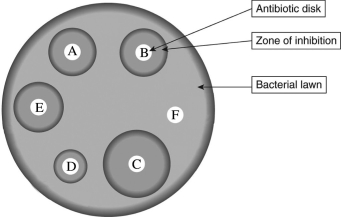Scenario
In order to test the susceptibility of bacteria (if the bacteria are susceptible to being killed) to an antibiotic, a common laboratory test called the Bauer-Kirby Disk Diffusion test is used. First, a petri dish (a shallow, circular, transparent dish with a flat lid) is partially filled with nutrient-enriched agar (a gelatinous material) . The nutrients encourage growth of specific bacterial species. The agar is poured as liquid but then typically solidifies to a soft consistency. Once the agar is set, a "lawn" of bacteria is spread such that a thin layer covers the top of the agar. Antibiotics are then applied to the lawn in a small dose, often through small, saturated paper disks. The dish is typically incubated for 24-48 hours and then observed for susceptibility. If the antibiotic is effective, it will kill the bacteria and leave a clear area called the "zone of inhibition" due to inhibited bacterial growth. The area starts at the source of the antibiotic and radiates outward. Scientists measure the diameter of the zone and then compare it to an established "cutoff value" for a zone specific to antibiotic/organism combinations. A large zone of inhibition in comparison to the standard indicates susceptibility while a small or no zone indicates resistance. Consider the following image, and answer the questions that follow: 
-What can you conclude about the susceptibility of the bacteria to the antibiotics?
A) The bacteria are more susceptible to antibiotic A than antibiotic C.
B) The bacteria are more susceptible to antibiotic D than antibiotic B.
C) The bacteria are more susceptible to antibiotic C than antibiotic E.
D) The bacteria are more susceptible to antibiotic D than antibiotic A.
Correct Answer:
Verified
Q37: Which result might be a consequence of
Q38: If the frequency of one allele in
Q39: In the Hardy-Weinberg formula, what does 2pq
Q40: Which explanation is most likely for a
Q41: Scenario
Over the past 60 years, many amphibian
Q43: Examine the relationships between the elephants in
Q44: Scenario
Over the past 60 years, many amphibian
Q45: Scenario
Drs. Peter and Rosemary Grant have been
Q46: Scenario
In order to test the susceptibility of
Q47: The accompanying figure shows the percent of
Unlock this Answer For Free Now!
View this answer and more for free by performing one of the following actions

Scan the QR code to install the App and get 2 free unlocks

Unlock quizzes for free by uploading documents